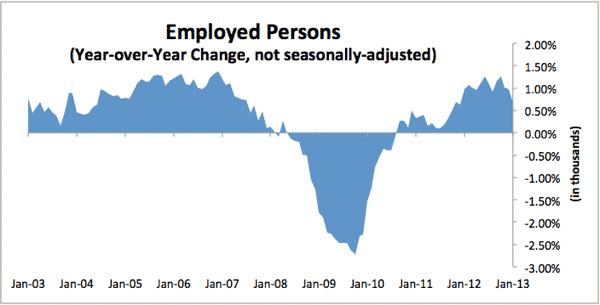Employment situation summary puts US cycle peak at June 2012
As you may have heard already, the jobs numbers for the US came out and they confirmed that the US private sector continues to create 150-200,000 new jobs each month. This is consistent with moderate and does not indicate any signs of recession. The US can only fall into a recession because of fiscal cuts that ricochet back onto the private sector.
Now, the US did show a contraction in output based on preliminary estimates of Q4 GDP. However, these numbers are preliminary and subject to revision. More importantly, however, they highlight that the shortfall in output is not coming from private demand, which is still relatively robust in the US. Rather, the contraction stemmed from cuts in government spending and an unexpected inventory purge, also potentially due to anticipated cuts in government spending.
The jobs data, on the other hand, were good. From the BLS:
Total nonfarm payroll employment increased by 157,000 in January, and the unemployment rate was essentially unchanged at 7.9 percent, the U.S. Bureau of Labor Statistics reported today. Retail trade, construction, health care, and wholesale trade added jobs over the month. …
The change in total nonfarm payroll employment for November was revised from +161,000 to +247,000, and the change for December was revised from +155,000 to +196,000. Monthly revisions result from additional reports received from businesses since the last published estimates and the monthly recalculation of seasonal factors. The annual benchmark process also contributed to these revisions.
In the absence of more cuts to government spending, I would expect the US economy to continue on a modest recovery track. We are in a period right now that is reminiscent of 2005 or 2006. If you think back to that period, the housing bubble was just beginning its blowoff phase. But, on the ground, many were still complaining the recovery was not robust. Yet, the economy had begun to add 1 to 2 million jobs per year according to the Department of Labor’s household survey. By September 2005, the household survey showed the economy adding almost 3 million jobs in the 12 months prior. I think this is the period we are entering now.
The key difference now is that the household sector is more indebted and more chastened after the credit boom of the last bubble than they were after the less credit-oriented bubble in stocks of the bubble just before. Again, in the absence of more government cuts, I would expect this recovery to continue and mature, with credit excesses starting to build due to the accommodative stance of fiscal and monetary policy. Note that the year over year numbers are actually declining somewhat now. They peaked at just over 3 million in June but now they are only 1.67 million according to the household survey. The decline is very large and, given previous cycles, this would suggest that this recovery is long in the tooth and starting to fade.

All that said, I do expect government spending to be cut and so I expect the recovery to be cut short prematurely. Let’s see how the US Congress deals with the sequester and we will have a good idea then of where we are headed. Employment is a key in terms of where to look for signs of recession. RIght now the employment data say continued recovery. But they also say we are beyond the peak for this economic cycle and are drifting toward the next economic trough.
Comments are closed.